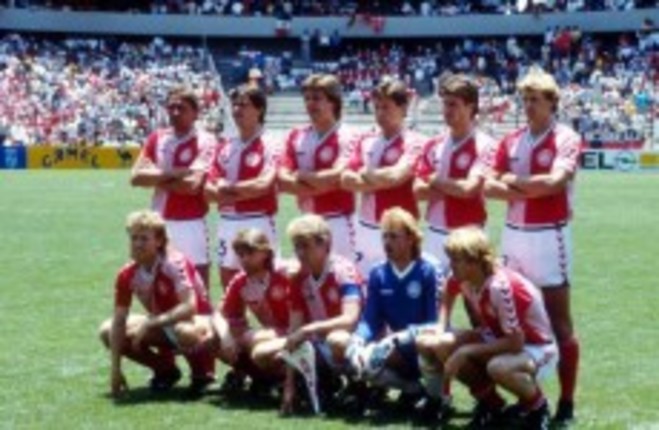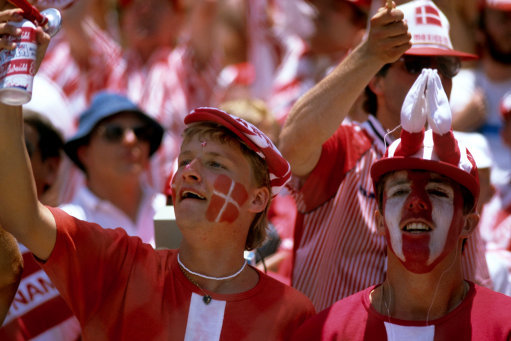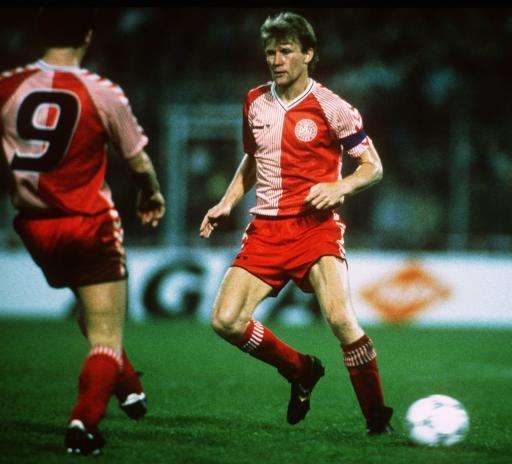Why we loved them:
AHEAD OF THE 1986 World Cup, Denmark manager Sepp Piontek said ‘ In Mexico we shall attack, like we always do’.
The side featured a glittering array of talent – the vast majority based overseas at immensely successful clubs. There was the captain, Morten Olsen, who had just been crowned a Belgian league champion with Anderlecht. Soren Lerby was at Bayern Munich – Bundesliga winners. Frank Arnesen had just claimed a Dutch league title with PSV while the 21 year-old mercurial midfielder Michael Laudrup had won a Scudetto with Juventus.
Sprinkled throughout the squad were a handful of other familiar names – Manchester United duo Jesper Olsen and John Sivebaek and Liverpool’s Jan Molby.
The Danes played with style and borrowed heavily from the Dutch team of 1974 to implement their philosophy. A handful of the squad left Denmark for Ajax as youngsters and quickly immersed themselves in a possession-based system built around awareness, movement and intelligence.
They scored goals for fun – usually through the wonderful Preben Elkjaer and relied on the pace, guile and imagination of Arnesen and Laudrup to craft the openings.
The team’s jersey was a classic too and complemented the elegance of the players wearing it. A white v-neck design with black trim, red and white halves on the body, a subtle pin-stripe was a neat twist and offered something fresh and unique. It was effortlessly cool.
Denmark could also rely on the incredible support of a dedicated fan-base. The Roligans (named after the Danish word for quiet) were colourful, calm and charming and were a suitably affable support-group for a brilliant side.
The story:
Denmark’s journey really began in 1984 when they reached the semi-finals of the European Championship.
They thrilled in the group stage, losing their opening game to eventual-winners France before thrashing Yugoslavia and scraping past Belgium in a thriller. With Arnesen and Elkjaer providing the goals, it was ironic that the latter’s missed penalty in a semi-final shoot-out with Spain cost the Danes a place in the decider.
But the side had momentum, although their qualification campaign for the 1986 World Cup was a little haphazard. From eight games, they lost twice and they went from a defeat to the Soviets and a scoreless draw at home to Switzerland to battering Norway in Oslo and racking up four against the Republic of Ireland in Dublin.
Having suffered a 3-0 defeat earlier the previous year in Copenhagen, Eoin Hand’s side were bamboozled on two separate occasions and former Irish striker Mickey Walsh remembers being in awe of the Scandinavians’ style and unique approach.
We were beaten 3-0 by the Danes. They were one of the best sides in Europe. So many teams play from the back nowadays — Denmark were doing that 30 years ago. Morten Olsen was such a cool customer. He played so deep. [Michael] Laudrup, [Preben] Elkjaer — they were fantastic.”
Denmark qualified for Mexico along with the Soviets and were drawn in what’s remembered as the very first Group of Death. They faced an ominous collection of teams in West Germany, Uruguay and Scotland but remained unaffected.
In their first game against a Scottish side managed by Alex Ferguson (Jock Stein had died suddenly the previous September), they were forced to wait an hour before making a breakthrough. But Elkjaer picked up a pass from Arnesen in the area, bustled through one challenge and drove his shot past Jim Leighton and into the far corner via the upright. The Danes were up and running.
They hit their stride in their next assignment against Uruguay. They were a goal in front after just eleven minutes when Laudrup teed up Elkjaer who finished it low to the net from an acute angle.
Shortly before the break, Elkjaer turned provider and pinged in a superb cross from the right side that fizzed along the six-yard area and found Lerby at the far post who easily applied the finishing touch. But, the South Americans responded in first-half injury time with a penalty from Enzo Francescoli and it gave the Danes some food for thought ahead of the second period.
Shortly after the restart though, Laudrup conjured a moment of individual brilliance (more on that later) to give the Danes a decisive 3-1 lead and from there they never looked back. Elkjaer added two more and finished with a hat-trick while Jesper Olsen scored too. Denmark thumped Uruguay 6-1.
Elkjaer’s third came from a Uruguayan attack that broke down on the edge of the Denmark area. It was end-to-end. It was a firm statement of intent. It was great to watch.
Next up was an assignment against the Germans and prior to the game, the Danes met to discuss their approach. A win or a draw would ensure a knock-out round clash against Spain. A loss against Franz Beckenbauer’s side would mean an easier game against Morocco.
But Denmark wanted to knock down another heavyweight. And their manager Piontek was a former German international. They wanted to win. And they did. But it came at a cost.
Olsen scored from the penalty spot and John Eriksen also popped up with a goal midway through the second half but, in the 89th minute, it was a case of disaster for Denmark.
With the game won, Arnesen was challenged from behind by Lothar Matthaus. Arnesen retaliated and, having already picked up a booking earlier in the game, he was sent-off.
It was silly and reckless and he knew it. His reaction to being dismissed said it all. He fell to one knee and placed his head in his hand. In an instant, the goodwill surrounding another impressive victory against a high-profile side was evaporated. Now minus a key player, Denmark knew they would be up against it in the next round.
And so it proved. Although the second-round game with Spain started brightly for Denmark, it swiftly fell apart for them. Olsen scored from the spot again shortly after the half hour but hero quickly turned to villain and Denmark paid for their possession-based system.
Just ten minutes later, Denmark had a goal-kick. As Lars Hogh assessed his options, Olsen dropped back into the area to pick up the ball but was shadowed by Julio Salinas. Still, Hogh played a risky pass.
Olsen dummied away from Salinas, created some space and made his way towards the right flank. Instead of looking for a team-mate further up the line or try to play a pass into the channel, Olsen inexplicably sent the ball back across his penalty area, hoping Hogh was there.
He wasn’t. Emilio Butragueno was and tapped into an empty net.
After the break, Spain grabbed a second. Butragueno scoring with a close-range header following some non-existent Danish marking at a corner. Denmark changed their formation and quickly lost their shape and their discipline. With twenty minutes left, Butragueno was left one-on-one and won a penalty that Goicoechea converted. Butragueno scored two more before the end. Spain won 5-1.
The dream was over.
Stand-out player:
Though Elkjaer, Arnesen and Laudrup combined magnificently up front, the Danish model always began at the back. Morten Olsen, the captain, dictated things from a deep-lying libero position but could easily push into midfield and was well-known for his penetrative runs.
In many ways, he was a late bloomer and spent a large part of his career as a utility player. But, in his later years he began to play regularly in central midfield and had the awareness to drop deeper and build from the back. He hit his peak in his early thirties when he moved to Anderlecht – where he won a number of Belgian titles as well as the UEFA Cup. But he also enjoyed considerable success with the national team.
In many ways, his flexibility and intelligence complemented the Danish side so much. The side’s philosophy was almost an extension of him.
Stand-out moment:
Denmark were 2-0 up against Uruguay in the group stage but just before the break, the South Americans scored from the penalty spot to get back in the game. Shortly after the restart however, the Danes conjured a sublime moment that essentially won them the match, turned a 21 year-old into a household name and anointed the Scandinavians as a much-loved World Cup side.
It began with Arnesen on the left, whose skill and pace got him to the by-line. The cross was a good one and poorly dealt with by the Uruguayan defence. The clearance fell to Lerby who used his right foot to control and his left to flick the ball over the head of a Uruguayan defender and find a team-mate on the right flank. He picked up the return pass and slipped it inside to Laudrup.
A quick shimmy got him around one tackle before cutting inside onto his right foot as he approached the edge of the area. He moved his weight onto his left side and used his pace to race past Victor Diogo and the goalkeeper Fernando Alvez before he tucked it home.
The video above is made by the ITV commentator John Helm who exclaims ‘The boy’s a genius’ as Laudrup celebrates.
Wonderful. Just like this team.





